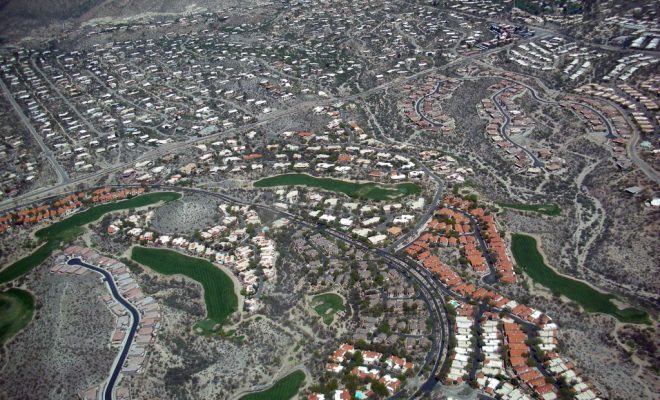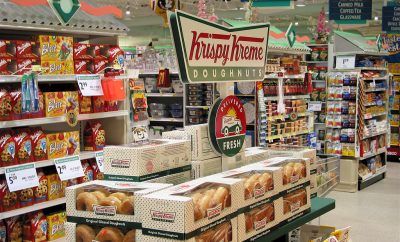 Suburbia" courtesy of [Daniel Lobo via Flickr]
Suburbia" courtesy of [Daniel Lobo via Flickr]
Business & Economics
The Middle Class is Shrinking: Why Does it Matter?
The middle class has been many things to many people, but more evidence indicates that it continues to get smaller. Many view the middle class as a key component to the American identity and a driver of economic expansion over the past several decades. For politicians, it is the group they campaign on helping the most in an increasingly contentious election.
But the middle class is shrinking–according to a recent Pew Research Center report, for the first time since the 1970s the middle class does not make up the majority of people in the United States. Read on to see how the all-important cohort is changing with the times, how it developed, what is rising to fill its place, and why all of this matters to the United States going forward.
What does the Middle Class Look like Today?
The first step in evaluating the middle class is to determine who actually meets that qualification. Unfortunately, there is no universally-agreed upon definition for the middle class. To categorize Americans, experts have looked at a variety of factors including demographics, income level, wealth, what people consume, and even their personal aspirations, but no standard has been agreed upon.
The Pew Research Center study focused on income, defining the middle class as those who earn two-thirds to two times the median income in the United States. Pew then adjusts its statistics for household size, using a three-person household as the benchmark. Those that fall in the lower-income bracket have an adjusted household income of $31,000 dollars or less per year. Americans who makes more than $188,000 annually are considered upper-income. At the edges of these groups are two more distinctions, dubbed “lower-middle income” and “upper-middle income.” The lower-middle group is defined as earning between $31,000 and $42,000 per year. On the other side, the upper-middle group’s income ranges from $126,000 to $188,000 per year. Those in between that range make up the middle-class.
As the demographics of the United States have changed over the past 40 years, so has the makeup of the middle class. For one, the middle-class today is far more educated than ever before. The proportion of people with at least some college experience increased and those with a high school diploma or less plummetted. Looking at trends over the past several decades, college-educated adults are currently much more likely to be in upper-income than in the past. While college-educated adults managed to maintain their economic status, those with less education fared much worse. As Pew points out, “Among the various demographic groups examined, adults with no more than a high school diploma lost the most ground economically.”
The middle class has also gotten older, much like the country at large, with a smaller proportion of people 44 years of age and younger and a greater percentage of people 45 and older. The middle class has also diversified, with Asian, black, and Hispanic populations taking on a bigger percentage of the pie. In the same vein, foreign-born citizens’ share of the middle class has also increased. The following video looks at the difficulty in defining the middle class:
Why the Middle Matters
The definition of what the middle class is is contested, but so is whether or not the middle class even matters.
Inequality and the Middle Class
One of the most widely discussed trends in recent years is the growing wealth gap between upper-income Americans and the rest of the country. The problem is not necessarily that the rich are getting richer, but whether they are doing so disproportionately and at the expense of the economy and everyone else.
Some argue that inequality is the result of actions by the federal government, namely through decreasing tax rates for the wealthy starting during the Reagan administration. Others contend that the effects of tax decreases are not nearly enough to account for the massive disparity that exists today. While many debate the exact causes of this inequality, its effects on the middle-class are important.
Several studies show that developing a strong middle class is the ideal recipe for economic success. This is true for several reasons, which the Center for American progress outlined in a recent report. One is that a strong middle class means more access to education and subsequently better trained human capital. Second, a stronger middle class creates a larger and more stable market for demand, especially in relation to a small elite that can only consume so much. Third, a strong middle class is a hotbed for the next generation of innovators; job growth comes primarily from expanding small businesses, not large corporations. Finally, a powerful middle class demands the necessary political and social goods required to improve an economy–from infrastructure to fair regulations that may be overlooked when politicians cater only to a small elite.
The Middle Class in Politics
In light of this growing inequality, it’s important to ask: does the middle class still matter? While terminology on the campaign trail may be changing, the middle class as an issue and the middle class as a group remain at the heart of American politics. Politicians from both parties have made courting the middle class essential to their electoral success–every 2016 candidate from Bernie Sanders to Rand Paul is working for the support of this elusive group. The question then is why, given that people with higher incomes are more likely to vote than those with lower incomes and the middle class is shrinking. The real reason why the middle class seemingly gets such an out-sized share of attention may have to do with how it formed and what it means to American ideals.
Origins of the American Class System
In the United States there originally existed two main groups of people, the proverbial haves and have-nots, an entrenched elite and everyone else. Beginning in the 19th century, however, this began to change as members of the lower class began to split into two separate spheres. In one sphere was the traditional manual laborer, or the working class. In the other was a new group, which would become the middle class. While manual workers moved from the farm into the factories, the burgeoning middle class worked white-collar jobs as clerks and small business owners.
In the process, these middle-class workers became better educated and skilled, which allowed them to rely more on ability and less on social networks. Thus, they were able to develop an individual identity while the working class was not. Additionally, they no longer had to rely on large social networks to achieve significant gains, which the working class did through means such as unions and strikes. Along with severing close community ties, the developing middle class also began buying homes, experienced shifts in gender norms, and managed to provide a better education for their children. This group, along with the working class, experienced a huge boom following the end of WWII. However, like any rush, it was short-lived and beginning in the 1970s the middle class began to stagnate.
Rise of the Margins
What started as stagnation has eventually led to decline. Since 1971, the middle class has shrunk from 61 percent of the population in 1971 to 50 percent this year. This decline has been gradual with no single defining moment. The people exiting the middle class, however, had to go somewhere and coinciding with this group’s reduction is a rise in people at the margins, in the low and high-income brackets. According to the Pew Research Center study, the percentage of Americans living in the lower income bracket rose from 16 percent in 1970 to 20 percent in 2015, the higher income group rose from 4 to 9 percent. While these two groups have grown at similar rates the amount of national income going to the upper income group has increased dramatically more, from 29 percent in 1970 to 49 percent in 2015. The video below highlights the plight of the middle class:
Aside from shrinking, the middle class has lost a significant amount of its wealth. Since 2000, this group has lost 4 percent of its median income. Additionally, due in large part to the housing-related effects of the recession, the wealth of the middle class has dropped an additional 28 percent. Those among the middle class who saw the biggest losses since the 1970s were Hispanics, people with only high school diplomas, young adults, and men. However, the changes within this cohort were not bad for everyone, as the elderly, women, blacks, whites, and married couples saw their positions improve.
Social Mobility
The changes within and outside of the middle class have not been the same for everyone. The main concern, however, is not so much whether you are in the middle class now, but whether can you reach or even surpass it. In the United States there has long existed the notion that through hard work, education, and possibly luck you can move up the class ladder; this concept is known as social mobility. More exactly, social mobility is the “movement of individuals, families, or groups through a system of social hierarchy or stratification.” If a person changes positions, typically by switching jobs, but does not change their class, that’s called horizontal mobility. If the changing role also leads to a change in class, either up or down, it’s vertical mobility. While the belief in social mobility remains strong, how realistic is it in the United States today?
Unfortunately, a recent study paints a troubling picture. As the Atlantic notes, the study found that roughly one-half of parental income advantage is passed on to children. The impact actually increases as people get wealthier, growing to two-thirds. What this means is that if someone has rich parents he or she is much more likely to be financially successful as well. This effect is greater for men and married couples than women and single people. Put simply, as the middle class is shrinking, the chances of improving one’s economic status also decreases.
Conclusion
While politicians continue to focus on helping middle-class voters, the number of people who fit that description, as well as their wealth and income, continue to shrink. Exactly what is driving this decline remains a subject of debate, but most argue that it is a combination of factors. The middle-class has been a culturally and economically important group for the United States for over a century, but as it shrinks its significance may fade. Recent economic changes identified by the Pew Research Center report highlight the importance of education to the American economy and the middle class. While people with college degrees maintain their economic status, those with less education have not fared nearly as well.
While the two major parties have debated the best course of action to take in fixing the middle as it has declined since the early 1970s, it is hard to argue that the middle does not matter. Not only has it been shown to be the engine of a growing and prosperous economy but it increasingly symbolizes the nation as a whole. Perhaps it would be prudent to address the challenges facing this all-important American bedrock before it is gone.
Resources
Primary
Pew Research Center: The American Middle Class is Losing Ground
Additional
Education Action: Social Class in the United States A Brief History
The Atlantic: America is Even Less Socially Mobile Than Most Economists Thought
CNN Money: What is middle class, anyway?
Pacific Standard: The IMF Confirms That ‘Trickle Down’ Economics Is, Indeed, a Joke
Center for American Progress: Middle-Class Series
New York Times: Middle Class is Disappearing, at Least from Vocabulary of Possible 2016 Contenders
Al Jazeera America: Most Americans Don’t Vote in Elections
The Atlantic: 60 Years of American Economic History, Told in 1 Graph
Encyclopedia Britannica: Social Mobility
NPR: The Middle-Class Took Off 100 years Ago…Thanks to Henry Ford?
Encyclopedia Britannica: Social Class
“








Comments